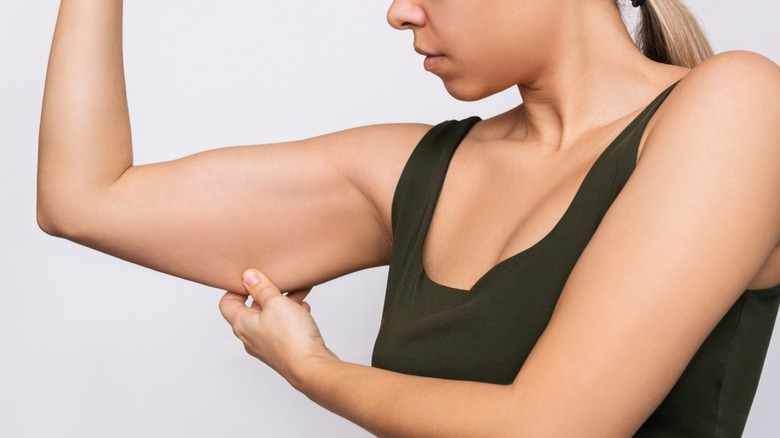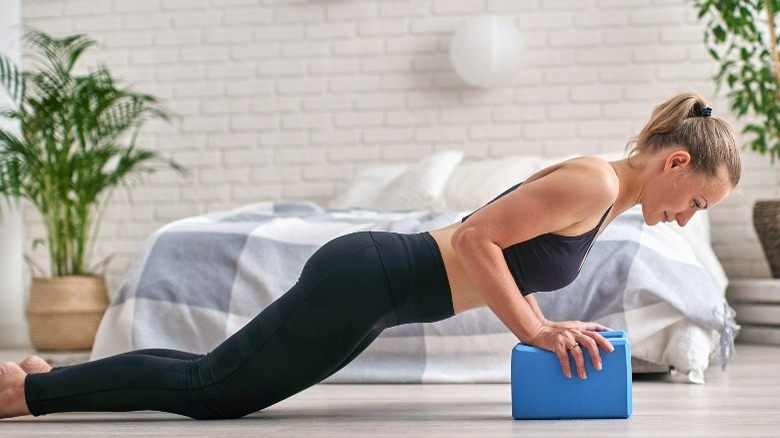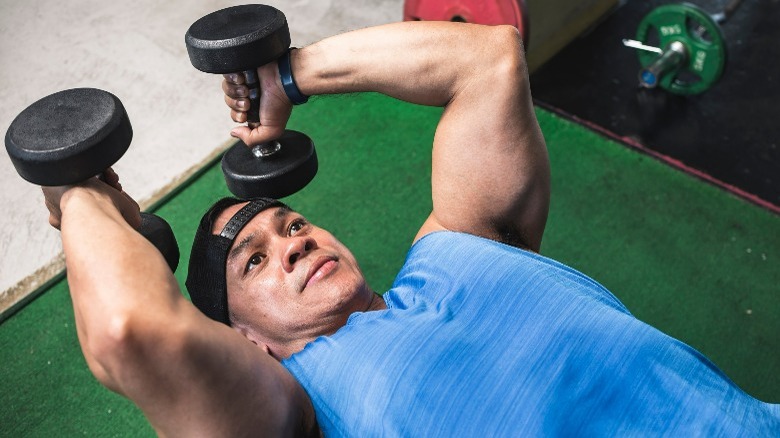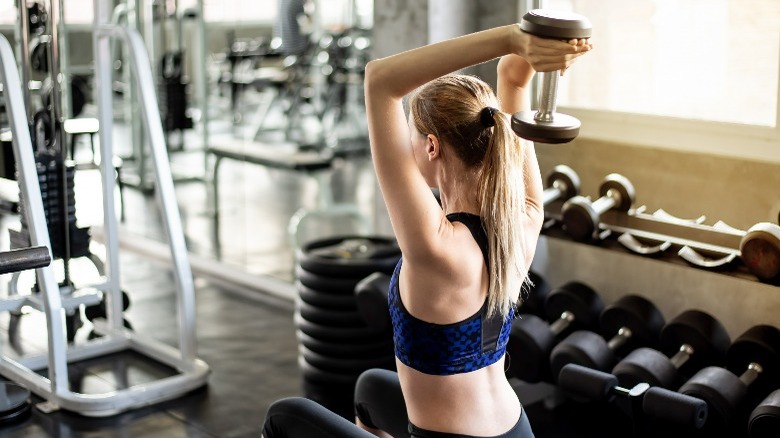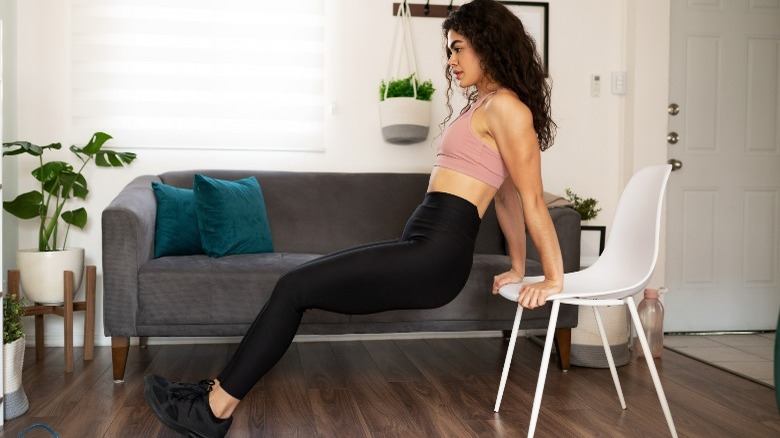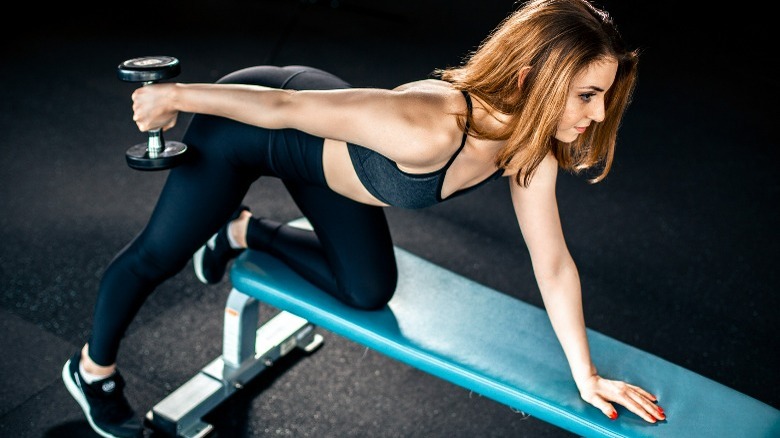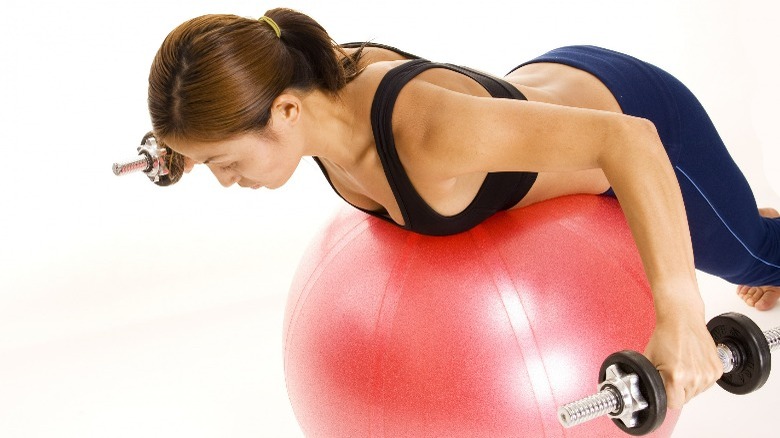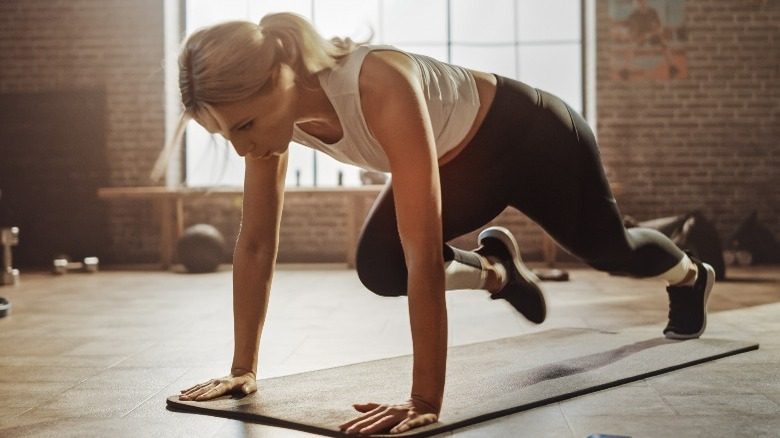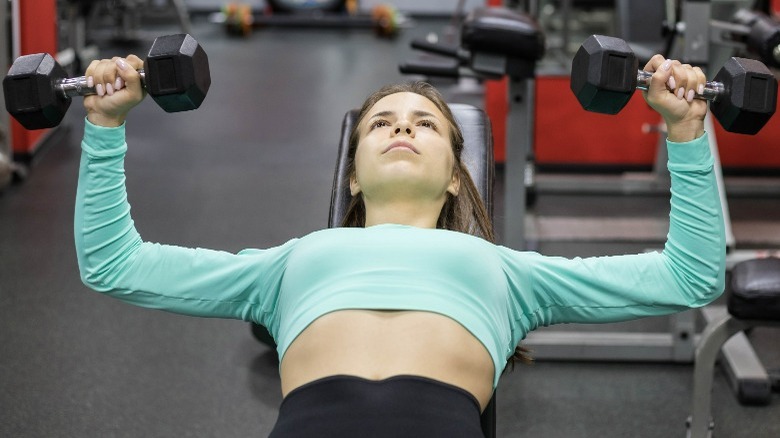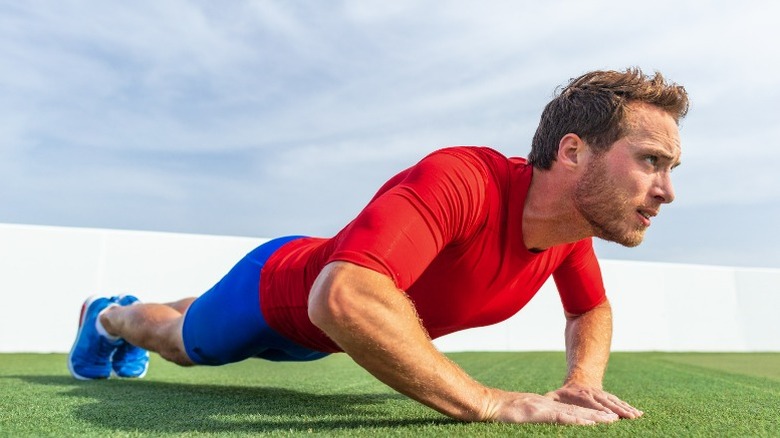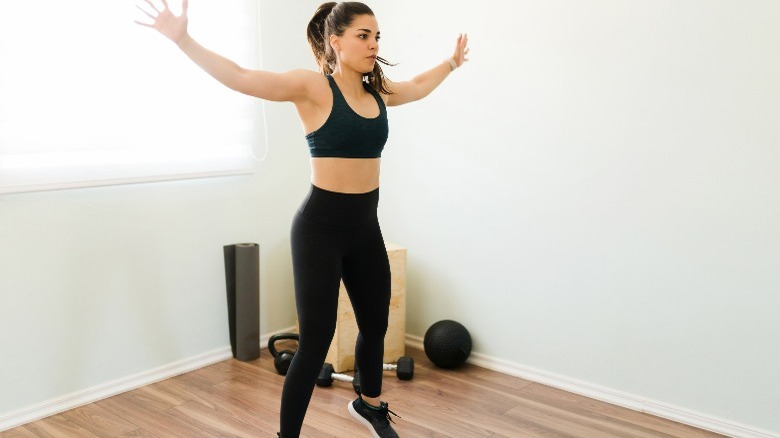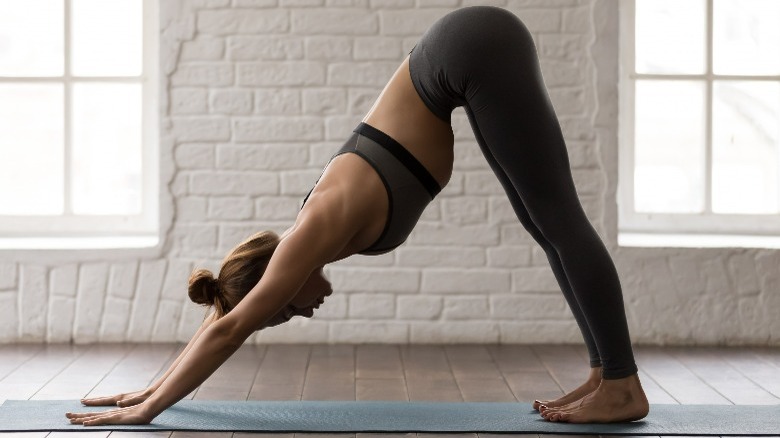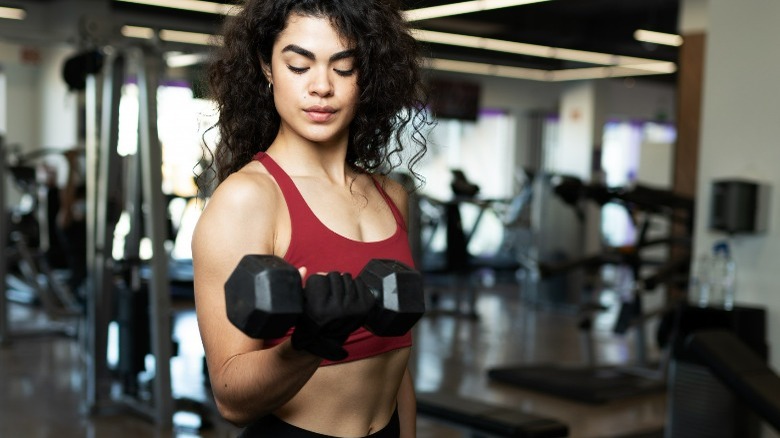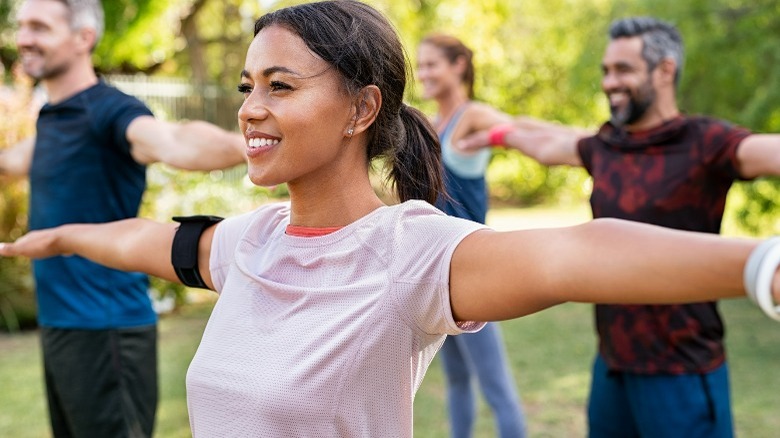The Best Exercises To Help Get Rid Of Underarm Fat
It's the bane of so many people's existence, but especially women over age 40: underarm flab (per CNN). While aging is a beautiful and natural process, it can pose challenges for those who want to maintain or achieve lean arms. According to CNN, some women have a genetic predisposition to store arm fat as they age. Additionally, aging reduces muscle mass and skin elasticity, causing certain body areas like the underarms to sag.
Before we dive into how to achieve those tank-top-ready arms, let's set some ground rules. First, there is no such thing as targeting a specific area for weight loss, otherwise known as "spot reduction." When we exercise, and particularly when we do cardio, fat cells are broken down and released into the bloodstream; thus the entire body burns these fat cells for fuel, not just the area being focused on (per Yale Scientific). Second, building muscle mass will not only help you look sculpted, but according to MedlinePlus, will increase your resting metabolic rate (the number of calories you burn while resting), since muscle burns more calories than fat. The takeaway: To strive for the body you want, integrate both cardio and weight training into your weekly exercise routine. A healthy diet is also a must. But it's also important to remember that while we all have body parts we wish we could change, everyone is built differently, and factors such as hormones, age, and stress can play a significant role in muscle tone and weight retention (via CNN).
It's always best to consult your doctor before undertaking a new lifestyle change. But if your health is in check and you're ready to tackle those jiggly arms, we've got you covered. Here are the best exercises to torch underarm fat.
Pushups
Wonder why practically every fitness routine includes pushups? That's because this tried-and-true exercise works so many body parts — arms, chest, shoulders, abs, legs, core (per Medical News Today). Best of all, pushups don't require any equipment and can be done virtually anywhere.
With such flexibility, you might be tempted to do this arm workout every day. While doing so can have its benefits, if you're not changing up your routine, you can plateau, or stop seeing or feeling results, as Healthline notes. It's therefore recommended to challenge yourself by increasing reps or trying different types of pushups (via Outside). Proper form is also key, Healthline notes; otherwise, injuries can occur. If pushups hurt your wrists or shoulders, try doing them on your knees or pushing against a wall. To increase the challenge while taking pressure off your wrists, you can do floor pushups using dumbbells to support your weight instead of your hands.
Healthline suggests beginning this exercise kneeling on an exercise mat, with your elbows bent, palms on the floor, and feet behind you. Then push up to a plank position, keeping your spine in a straight line, your abs pulled in, and your shoulders over your wrists. Then slowly lower your body to the floor until your chest touches the ground. Repeat 10 times, or for as long as you can maintain proper form.
Skull crushers
The name may sound like a form of medieval torture, but skull crushers — a triceps-extension exercise (via Healthline) — can work wonders for saggy underarms, suggests Today. Known as an isolation exercise, meaning it primary engages one muscle group, skull crushers target the long head of the triceps brachii (per University of Washington). As Physiopedia explains, the triceps brachii is a group of muscles on the back of the arm responsible for straightening, or extending, the elbow. This muscle group has three "heads" — lateral, medial, and long — that attach to different anchor points on the back of the arm and the shoulder blade that assist with stabilization during movement. While all three tricep heads work together to extend the elbow, the long head "generates a significantly higher muscle force and muscle activation," notes a 2018 study in Acta Orthopaedica et Traumatologica Turcica.
To perform skull crushers, Mindbodygreen recommends lying on your back with a dumbbell in your hands, extending your arms toward the ceiling. Then, bend your elbows, lowering the weight toward your forehead. Repeat this movement 8 to 12 times (per Mindbodygreen). When getting acquainted with any weight-training exercise, it may be best to start with lighter weights and higher reps to learn proper form, reports Self. That advice can especially come in handy for skull crushers — which has its terrifying name for a reason!
Overhead triceps extension
Although the triceps are primarily known for elbow extension, they also assist in push and pull movements, especially from an overhead position, as well as stabilizing the shoulder joint (per Healthline). Focusing on this muscle group helps you not only achieve sleek and sculpted arms, but also perform daily activities more efficiently (via PureGym).
Whether you're a novice or a fitness guru, overhead triceps extensions are a straightforward exercise and a great way to isolate the triceps. As with any exercise, correct form produces the best results. Triceps overhead extensions can be done standing or sitting, though standing will work your core and glutes more, suggests Healthline. Grab one heavy dumbbell, or two light ones, stretch your arms toward the ceiling, then lower the weights behind your head, repeating the movement 8 to 12 times for two to three sets (per MasterClass). Make sure to keep your elbows close to your ears and your tailbone tucked in instead of arching your back, notes HuffPost.
Triceps dips
We're all about recommendations that give you the biggest bang for your buck. When it comes to arm exercises, triceps dips are the gold standard (per Women's Health). After incorporating these into your regular fitness routine, those droopy triceps won't stand a chance. But triceps dips aren't just a great workout for your triceps – they also engage your deltoids (those triangular-shaped muscles on the top of your shoulders), your chest, and your core. What's more, you're not restricted to the gym. You can do triceps dips anywhere! Pull up a chair, or clear a space on your coffee table, and get to work.
Start in a seated position. Your knees can be bent or, for a bigger challenge, extended. Push your bottom off the seat, using the palms of your hands to support the bulk of your weight. While in this position, lower yourself toward the floor until your elbows are at a 90-degree angle. Your bottom should not reach the floor. Then, push up, extending your elbows until your arms are completely straight. Repeat this exercise for two to three sets of 10-15 reps. Healthline recommends avoiding common mistakes, such as flaring your elbows outward (you want them grazing your ribcage), going too low, not dipping low enough, or moving too quickly. You always want to be in control of your movements, so work at your own pace.
Triceps kickbacks
No arm workout routine would be complete without triceps kickbacks. This exercise, according to WebMD, isolates all three heads of the triceps brachii. While the site notes that injuries are uncommon with triceps kickbacks, it's important to listen to your body and modify exercises when necessary. If using dumbbells for this workout feels uncomfortable, WebMD suggests using resistance bands or a bench.
To begin, hold a dumbbell in each hand with your palms facing each other at your sides (via Healthline). Hinge forward at your waist, keeping your spine neutral while bringing your torso parallel to the floor. Keep your elbows close to your ribcage and extend your arms behind you, giving your triceps a squeeze as you reach full extension. Healthline recommends doing two to three sets of 10 to 15 reps. If preferred, you can also perform the exercise with only one arm at a time, and then switch. During this exercise, only your forearms should be moving. Avoid using momentum to propel your movement. A good mantra for this exercise: Slow and steady wins the race.
Reverse fly
Doing exercises that engage multiple muscle groups is always a win. Why? Well, for starters, working more muscle groups burns more calories, notes Time. Remember, losing fat overall is an important factor in slimming down a troublesome body part, and consuming fewer calories while increasing physical activity will help you achieve that (via Livestrong). The reverse fly is an excellent arm exercise that works many major muscle groups in the upper body, including the triceps, deltoids, trapezius muscles, and rhomboids (per WebMD).
Another bonus: Incorporating a reverse fly into your workout routine can help with bad posture. In a 2017 study analyzing strengthening exercises for chronic low-back pain, 20 men were split into two groups (per Journal of Sports Science & Medicine). The first group was tasked with doing only low-back exercises, while the other group worked both the upper and lower back. The group with the upper- and lower-back workout routine saw significant improvement in chronic pain as well as increased low-back strength.
To perform a reverse fly, hold a dumbbell in each hand with palms facing each other (via Mayo Clinic). Hinge forward at the hips and squeeze your shoulder blades together to lift your arms parallel to the floor, keeping a slight bend in your elbows. You can perform this exercise while sitting or standing. Make sure to keep your back straight and stable.
Mountain climbers
If there's another part of the body that nettles many folks, it's the lower-tummy area. Why not kill two birds with one stone and trim your waistline while sculpting your arms? Enter mountain climbers, a full-body exercise that works all major muscle groups and gets your heart pumping, burning additional calories and torching fat. Health Shots notes that mountain climbers also improve heart health (as they are a surefire way to get your heart racing), build muscle strength, and increase flexibility.
This exercise is simple enough to do. Start in a plank position, with your spine neutral and your shoulders in line with your wrists. Bring each knee to your chest one at a time. To add cardio, switch your legs at a faster pace, almost as if you're running. Healthline recommends two to three sets of 10 to 15 slow repetitions. If you're adding the cardio component, the site suggests six to eight rounds for 20 seconds, with a 10-second rest in between each round.
Chest press
There's a common misconception that bench presses are mostly for men. But it turns out, working this area is beneficial for everyone. According to Health Shots, doing chest presses regularly improves bone health, increases calorie burn, and tones the core and the triceps (bat wings, begone!).
Chest presses are also a great exercise for strengthening the upper body. Strengthening these muscle groups is important because as we age, we lose muscle mass (via CNN). This can lead to poor posture, or in the case of weak chest, back, and core muscles, kyphosis, commonly referred to as a "hunched back" (via WebMD). "When the mechanics of your joints change [due to kyphosis], it can cause dysfunction in any of the [interdependent] joints," Theresa Marko, an orthopedic physical therapist, told WebMD. "It's like a kinetic chain."
To perform this exercise, Healthline recommends lying flat on an exercise bench while keeping your feet pressed into the ground. Begin by lifting the dumbbells in front of you, forming two goal posts with your arms. On the inhale, bend your elbows and lower the weights to your chest. On the exhale, press the weights toward the ceiling, or back to your starting position, making sure to keep a slight bend in your elbows. Healthline suggests two to three sets of eight to 15 repetitions, but do what feels comfortable for you.
Triangle pushups
If you're a glutton for punishment, give triangle (or diamond) pushups a try. While your arms might be screaming the day after, trust us, it'll be worth it. In a study sponsored by the American Council on Exercise (ACE), 15 females ages 20 to 24 performed eight common triceps exercises with electromyographic (EMG) electrodes attached to the backs of their arms to measure the intensity of muscle activation. According to one of the study's researchers, Brittany Boehler, "All across the board, the triangle push-ups elicited the most muscle activity in our subjects."
To perform a triangle pushup, assume a plank position, either on your toes or, for an easier option, on your knees. Bring your index fingers and thumbs together to form a triangle or diamond shape. Squeeze your thighs, core, and glutes for stability, then lower your body toward the floor, hovering six inches from the ground and keeping your elbows pointed behind you. Inhale, and return to your starting position. Do as many as you can in two to three sets while maintaining proper form. Women's Health also recommends doing these at the beginning of your workout when you feel your strongest so that you can execute them more efficiently.
Jumping jacks
If your goal is to lose underarm fat, weightlifting alone won't cut it. Cardiovascular exercise is an important component of a well-balanced fitness plan. Specifically, high-intensity interval training (HIIT), which involves short bursts of intense activity punctuated by recovery periods, can burn more calories in less time (per Healthline). Enter jumping jacks. Doing jumping jacks every day isn't just an entertaining way to kill a few minutes on your work break; it's an excellent, equipment-free option for HIIT and will melt away unwanted fat, including those stubborn extra pounds on the belly (via Livestrong). Additionally, as Jonathan Mike, a strength and conditioning coach and professor of exercise science and sports performance, told Insider, "Jumping jacks have a wealth of benefits like mobility, increased blood flow, training in the frontal plane, and overall joint motion."
This exercise is also great to do in between strengthening exercises, helping you to build endurance and agility by switching between high- and low-intensity exercises. In fact, according to Outside magazine, combining weights and cardio during a workout will torch calories like nothing else. So, if you're looking to get the most out of your workouts, unleash your inner child and get to jumping.
Downward dog
If high-intensity exercises aren't your thing, you can't go wrong with yoga. This gentle, meditative workout will not only center you, but will improve posture as well as strengthen and stretch several major muscle groups in the body, according to Yoga Journal. While there are many yoga postures that help tone the arms, downward dog is an excellent isometric exercise for the upper body (via Livestrong). Isometric exercise, according to Healthline, is any type of static movement that contracts a muscle without changing the muscle's length. Best of all, you can do this move anywhere, and it feels oh so good.
Yoga Journal recommends starting this exercise on your hands and knees with your arms stretched out in front of you and your palms touching the ground. Exhale and push up off your knees, stretching your tailbone toward the ceiling, forming a triangle shape with your body. Gently lower your heels as far as you can comfortably. Hold this pose for 10 breaths and return to starting position. Self notes that this posture is great for relieving stiffness and pain in the back and shoulders. As yoga teacher and life coach Sophie Herbert told the magazine, "Practicing [downward dog] with proper alignment can make your upper back more flexible and less likely to store so much tension."
Bicep curls
When we think underarm fat, we think triceps (per CNN). But it's important to give the biceps some love too, because they move in opposition to the triceps. Working antagonist muscles, the muscles that contract when opposing muscle groups relax, is critical to strengthening the muscles you want to tone and increasing range of motion (via Chron). In a 2005 study, researchers observed 24 college-aged rugby players to determine if working both agonist muscles (muscles that contract during an action) and antagonist muscles at the same time improved power output. The results showed that alternating between antagonist and agonist muscle exercises could "acutely increase power output during complex power training."
Bicep curls can give your arms a lean, chiseled look while increasing upper-body strength (per Today). Start this exercise seated or standing with your feet hip-width apart while holding a dumbbell in each hand. Tighten your abs and, if you're standing, keep a soft bend in your knees. With your palms facing forward, raise the dumbbells toward your shoulders, keeping your shoulders down and elbows tucked close to your ribcage. Today recommends three sets of 10 repetitions. If you're a beginner, start with lighter weights to protect your back and help you stay in control of your movements.
Arm circles
Don't let the simplicity of this exercise fool you. After doing about 10 seconds of arm circles, you will feel the burn. If you're looking for a dynamic warmup routine before your workout, arm circles are it. This movement works the triceps, biceps, back, and shoulders (per Times of India). You can also perform arm circles daily, and they are especially beneficial if you work long hours in front of a computer, as lack of circulation and stretching can stiffen joints and increase risk of injury, notes MedicineNet. And, of course, arm circles can help tackle arm fat, especially when paired with other arm-toning exercises.
Another reason arm circles are a go-to exercise is that they require no equipment, and you can do them anywhere. Begin with your feet should-width apart, raising your arms out to your sides so that they are in line with your shoulders and parallel to the floor. Next move your arms in small circular movements while keeping them level with your shoulders. Healthline recommends doing this motion for 10 seconds before reversing directions. You can do these until your arms feel fatigued, or aim for five to seven minutes every day.

